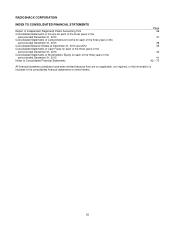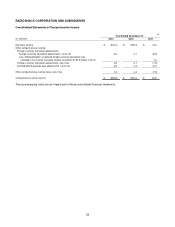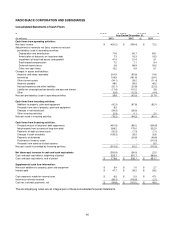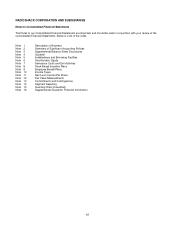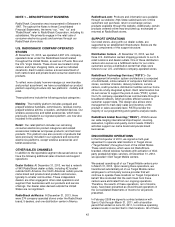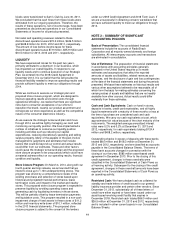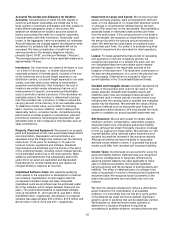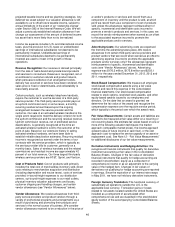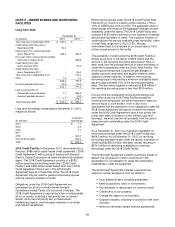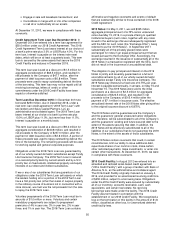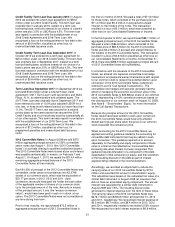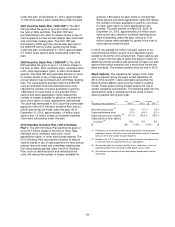Radio Shack 2013 Annual Report Download - page 46
Download and view the complete annual report
Please find page 46 of the 2013 Radio Shack annual report below. You can navigate through the pages in the report by either clicking on the pages listed below, or by using the keyword search tool below to find specific information within the annual report.44
kiosks were transitioned to Sam’s Club by June 30, 2011.
We concluded that the cash flows from these kiosks were
eliminated from our ongoing operations. Therefore, the
results of these operations, net of income taxes, have been
presented as discontinued operations in our Consolidated
Statements of Income for all periods presented.
Net sales and operating revenues related to these
discontinued operations were $72.2 million, $426.5 million
and $408.8 million for 2013, 2012 and 2011, respectively.
The amount of loss before income taxes for these
discontinued operations was $7.9 million, $35.9 million and
$10.5 million for 2013, 2012 and 2011, respectively.
LIQUIDITY
We have experienced losses for the past two years,
primarily attributed to a downturn in our business, which
has impacted our overall liquidity. In response to our
liquidity needs and to continue execution of our Strategic
Plan, we entered into the 2018 Credit Agreement in
December 2013. It is our belief that this will provide the
financial flexibility needed to improve operating results and
provide sufficient liquidity to meet our obligations through
2014.
While we continue to execute our strategic plan and
proposed store closure program, which are designed to
improve operating results and control costs through
operational efficiency, we realize that there are significant
risks due to consumer acceptance of our efforts to
reposition the brand, revamp our product assortment and
reinvigorate our store experience as well as the competitive
nature of the consumer electronics industry.
As we execute the strategic turnaround plan and move
through 2014, we will be tightly managing our cash and
monitoring our liquidity position. We have implemented a
number of initiatives to conserve our liquidity position
including activities such as reducing our capital
expenditures, reducing discretionary spending and selling
surplus property. Many of the aspects of the plan involve
management’s judgments and estimates that include
factors that could be beyond our control and actual results
could differ from our estimates. These and other factors
could cause the strategic turnaround plan and the proposed
store closure program to be unsuccessful which could have
a material adverse effect on our operating results, financial
condition and liquidity.
Store Closure Program: On March 4, 2014, along with our
fourth quarter earnings release, we announced that we
intend to close up to 1,100 underperforming stores. This
program was driven by a comprehensive review of the
existing store base and selection of stores based upon
historical and projected financial performance, lease
termination costs, and impact to the market and nearby
stores. This proposed store closure program is expected to
preserve liquidity by avoiding operating losses and
generating cash by liquidating inventory in those stores.
This will be partially offset by lease termination payments
and liquidation costs. This program resulted in a non-cash
impairment charge of fixed assets in these stores of $11.2
million and inventory write down of $10.1 million, reflected
in the 2013 financial statements. The proposed store
closure program is subject to the consent of the lenders
under our 2018 Credit Agreement and 2018 Term Loan. If
we are unsuccessful in obtaining consent, we believe that
we have sufficient liquidity to meet our obligations through
2014.
NOTE 2 – SUMMARY OF SIGNIFICANT
ACCOUNTING POLICIES
Basis of Presentation: The consolidated financial
statements include the accounts of RadioShack
Corporation and all majority-owned domestic and foreign
subsidiaries. All intercompany accounts and transactions
are eliminated in consolidation.
Use of Estimates: The preparation of financial statements
in accordance with accounting principles generally
accepted in the United States requires us to make
estimates and assumptions that affect the reported
amounts of assets and liabilities, related revenues and
expenses, and the disclosure of gain and loss contingencies
at the date of the financial statements and during the periods
presented. We base these estimates on historical results and
various other assumptions believed to be reasonable, all of
which form the basis for making estimates concerning the
carrying values of assets and liabilities that are not readily
available from other sources. Actual results could differ
materially from those estimates.
Cash and Cash Equivalents: Cash on hand in stores,
deposits in banks, credit card receivables, and all highly
liquid investments with a maturity of three months or less at
the time of purchase are considered cash and cash
equivalents. We carry our cash equivalents at cost, which
approximates fair value because of the short maturity of the
instruments. The weighted-average annualized interest
rates were 0.2% and 0.2% at December 31, 2013 and
2012, respectively, for cash equivalents totaling $124.4
million and $408.2 million, respectively.
Outstanding checks in excess of deposits with these banks
totaled $8.0 million and $108.3 million at December 31,
2013 and 2012, respectively, and are classified as accounts
payable in the Consolidated Balance Sheets. The terms of
these bank accounts changed in connection with the
closing of our five-year, $585 million asset-based credit
agreement in December 2013. Prior to the closing of this
credit agreement, changes in these overdrafts were
classified in the Consolidated Statement of Cash Flows as
a financing activity. Subsequent to the closing of the credit
agreement, changes in these overdraft amounts have been
reported in the Consolidated Statements of Cash Flows as
an operating activity.
Restricted Cash: We have pledged cash as collateral for
standby and trade letters of credit issued to our general
liability insurance provider and certain other vendors. Since
December 31, 2013, substantially all of these letters of
credit have either expired or have been issued under our
asset-based revolving credit facility that expires in
December 2018. Restricted cash totaled $66.0 million and
$26.5 million at December 31, 2013 and 2012, respectively,
and is included in other current assets in our Consolidated
Balance Sheets.



